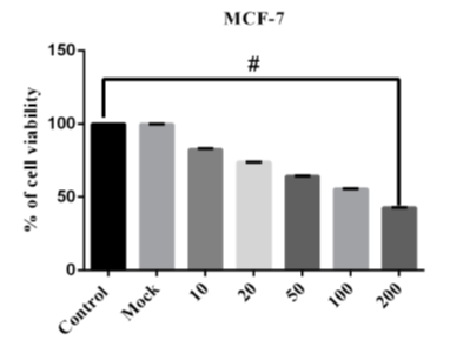


Indian Journal of Science and Technology
DOI: 10.17485/IJST/v14i43.1719
Year: 2021, Volume: 14, Issue: 43, Pages: 3199-3209
Original Article
Rajesh Kannan Moorthy1, Chandhru Srinivasan1, Sridharan Jayamohan1, Mahesh Kumar Kannan, Siva Sankari Thirugnanam1, Janaki Sankar Ganesh2,Antony Joseph Velanganni Arockiam1*
1Molecular Oncology Lab, Department of Biochemistry, School of Life Sciences, Bharathidasan University, Tiruchirappalli-620 024, Tamilnadu, India
2Department of Biomedical Sciences, School of Life Sciences, Bharathidasan University,|Tiruchirappalli620 024, Tamilnadu, India
*Corresponding Author
Email:[email protected]
Received Date:17 September 2021, Accepted Date:25 November 2021, Published Date:14 December 2021
Background: The purpose of the present investigation is to unravel the influence of the miR-375 inhibitor on cell survival descent and apoptosis stimulation, mediating PI3K/Akt/mTOR signaling network in human breast cancer cells. Methods: MCF-7 cells were transfected with miR-375 inhibitor for 72 h. Then, cell survival assay was measured by MTT. Cells were stained with EtBr/AO, DAPI, and DCFH-DA to assess the effect of the miR-375 inhibitor on cell death. A scratch experiment was performed to observe the cell migration ability. The expression of anti-apoptotic and apoptotic genes such as BCL-2, BAX, and PI3K/Akt/mTOR and miR-375 were evaluated in miR-375 inhibitor transfected cells by qRT-PCR. Findings: MiR-375 inhibitor sensitized tumor cells and influenced significant loss in the breast cancer cell proliferation with obvious cell death elevation. MiR-375 inhibitor effectively augmented ROS generation. Also, miR-375 inhibition hampered migratory ability. Furthermore, our qRT-PCR analysis showed that inhibition of the miR-375 was able to significantly reduce the constitutive expression of PI3K/Akt/mTOR mRNAs. Additionally, miR-375 suppression decreased the anti-apoptotic gene, Bcl- 2 expression and enhanced pro-apoptotic gene, Bax expression along with potentially decreasing miR-375 level compared to control. Novelty and applications: Inhibition of the miR-375 has considerably attenuated cell proliferation and stimulated apoptotic cell death in the breast cancer cells. Thus, miR-375 represent a potential therapeutic target for the breast cancer.
Keywords: Breast Cancer; Proliferation; Apoptosis; Migration; miR-375
© 2021 Moorthy et al. This is an open-access article distributed under the terms of the Creative Commons Attribution License, which permits unrestricted use, distribution, and reproduction in any medium, provided the original author and source are credited. Published By Indian Society for Education and Environment (iSee)
Subscribe now for latest articles and news.